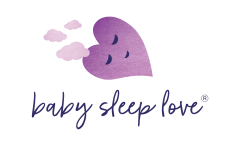
Baby Sleep Love
Certified Sleep Consultant
Is Your Baby Sleeping Safely? October is Safe Sleep Awareness Month—Essential Tips for Every Parent
Since October is not just for Halloween, let’s also talk about it being Safe Sleep and SIDS Awareness Month. Let’s review all the ways to protect your baby’s sleep and reduce the risk of Sudden Infant Death Syndrome (SIDS). With these simple adjustments, you can create a safe and secure sleep environment for your little one. Let’s dive in!
The “DOs” of Safe Sleep Tips
👉 Always place your baby to sleep on their back on a firm, flat, and non-inclined surface like a crib, bassinet, or cradle. This is essential for safe sleep.
👉 Keep the crib clear of all objects other than a fitted sheet over a firm infant mattress: no pillows, blankets, toys, or crib bumpers (even “breathable” bumpers), as these can increase the risk of suffocation, strangulation, and other injuries.
👉 Keep your younger baby nearby on a separate sleep surface, which keeps them safe and you close by for care. Room sharing and breastfeeding are considered additional protective factors.
👉 Swaddle with care. Stop swaddling at the first signs of rolling, or earlier (since a baby can do their first roll in their sleep without giving any indications they were ready to do so during the day).
👉 Make sure all caregivers are educated on safe sleep practices. Everyone involved in your baby’s care should follow these same guidelines.
Now that we’ve got a nice list of what we should be doing, let me share with you what you certainly don’t want to be doing if you want to keep your baby safe.
The “DON’Ts” of Safe Sleep Tips
👉 Avoid smoking or substance use around your baby. Exposure to secondhand smoke significantly increases the risk of SIDS.
👉 Avoid inclined sleepers or positioners, e.g., rockers, swings, “baby nests”. Although their appeal is understandable since they can lead to longer sleep, they are unfortunately not safe for sleep. If your baby falls asleep in one of these, it’s best to move them onto a safe sleep surface as soon as possible.
👉 Avoid any products not designed for sleep, like infant loungers, for naps or overnight sleep.
👉 Avoid sleeping on adult mattresses or soft furniture.
👉 Avoid weighted blankets, swaddles, or sleepers. Weighted objects can restrict movement and cause harm.
👉 Don’t rely on commercial products that claim to reduce SIDS risk. No product has been proven to do so effectively.
Remember that unsafe sleep does not become safer if it is supervised, and safe sleep practices apply to both daytime and nighttime sleep.
Read more about safe sleep from the Public Health Agency of Canada and the American Academy of Pediatrics.
safe sleep for babies, infant sleep safety, safe sleep awareness month, baby sleep guidelines, reduce SIDS risk, newborn sleep safety tips, baby sleep tips, safe sleep month, safe sleep practices, protect baby sleep, baby safe sleep advice, sleep safety for newborns, SIDS prevention tips, sleep environment for baby, safe sleep tips, baby sleep basics, baby crib safety, baby sleep guidelines, best sleep position baby, SIDS risk factors, baby sleep support, safe sleep habits, infant sleep, pacifier sleep safety, safe sleep checklist, firm crib mattress, avoid crib bumpers, flat baby sleep surface, sleep training baby, baby sleep support
Have a baby around 4 months old that is suddenly not sleeping as well as they used to? It could be the 4-month sleep regression, which often hits parents hard.
Got a sleep situation that can’t be solved by the Baby Sleep Basics? Maybe it’s time to consider signing up for one of my Certified Sleep Consultant packages.
Follow Baby Sleep Love on Facebook and Instagram to get regular, free sleep advice.
